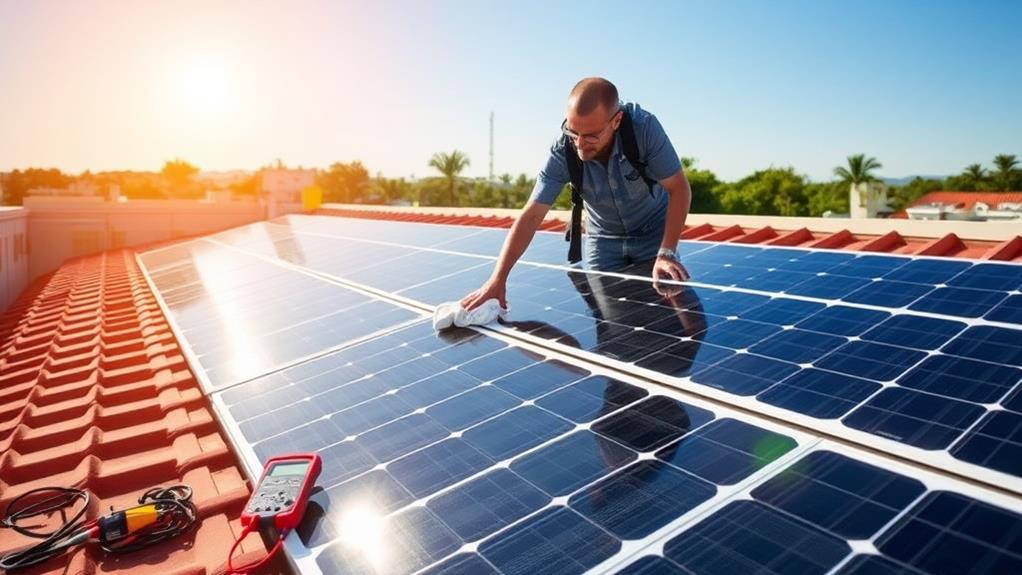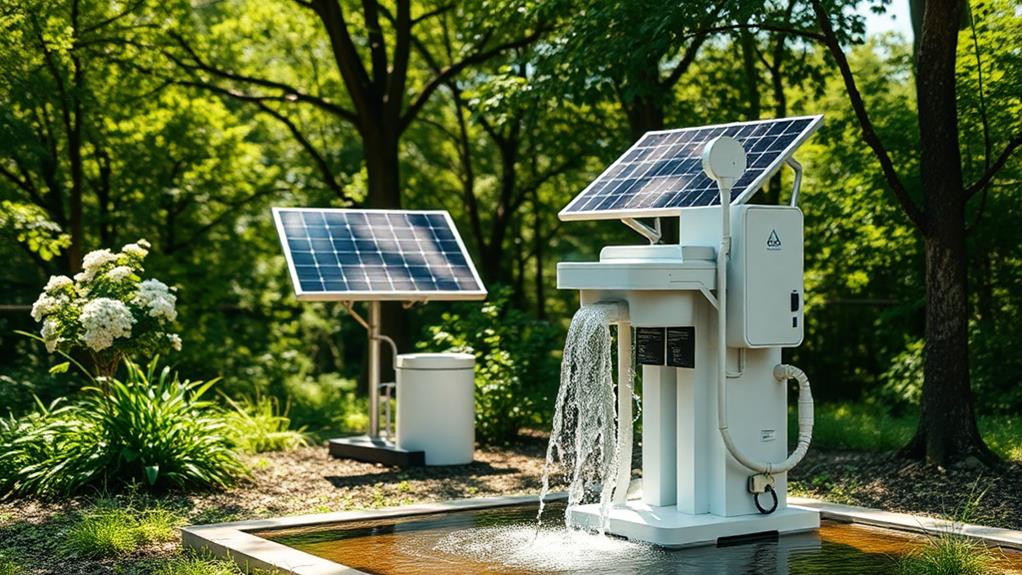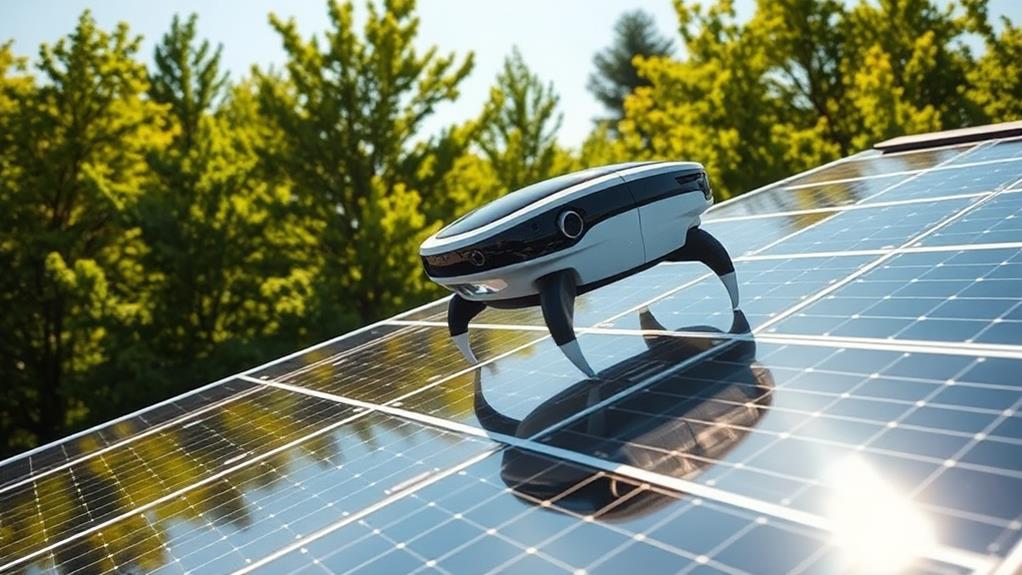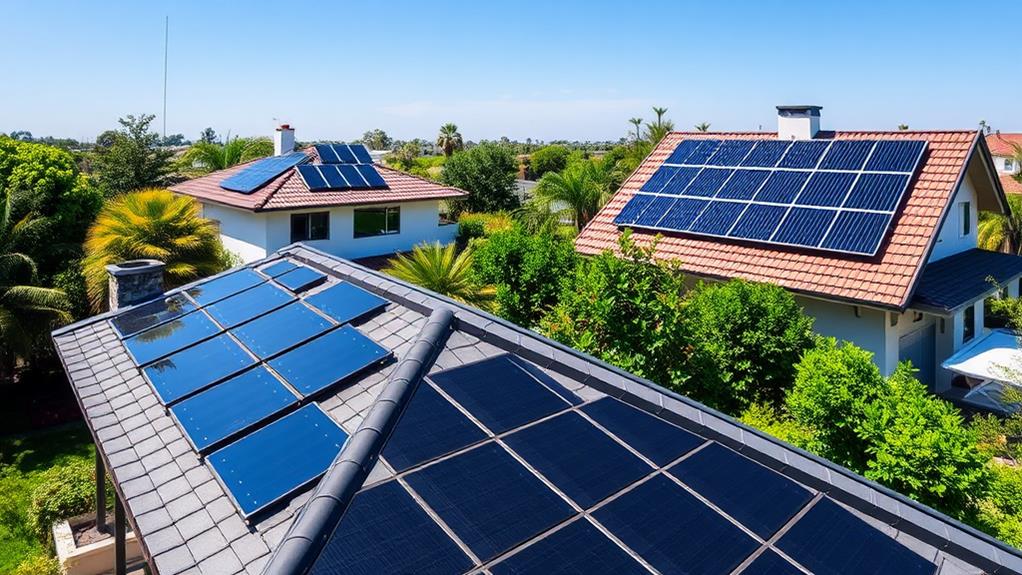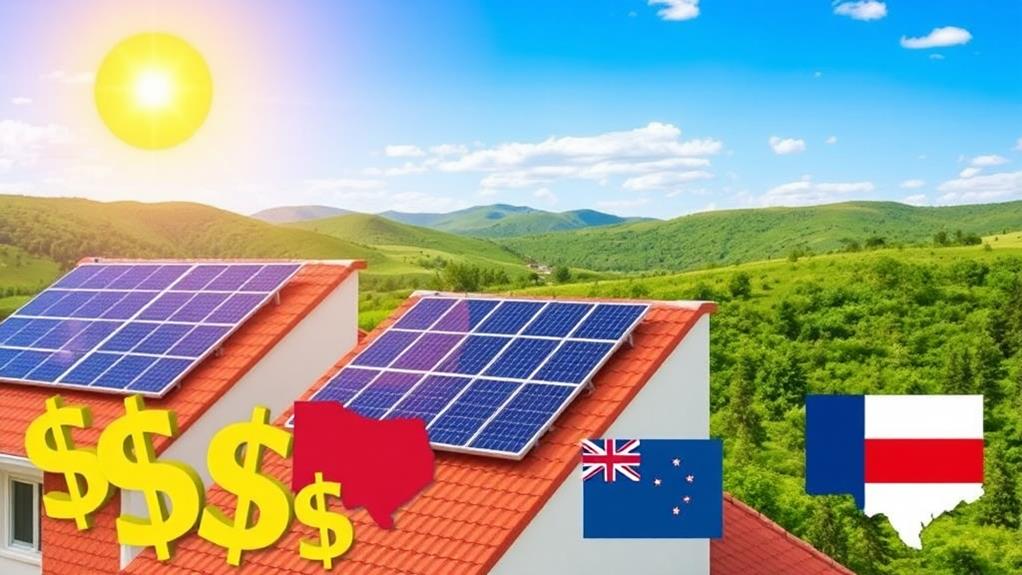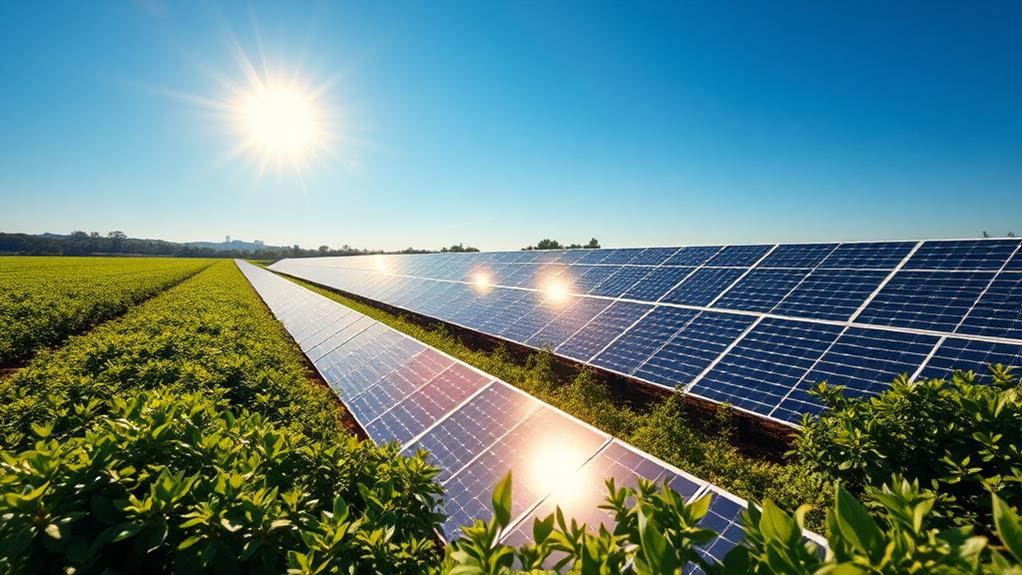Building-Integrated Photovoltaics (BIPV) have numerous real-world applications that enhance energy efficiency and sustainability across various sectors. In residential settings, BIPV materials, like solar shingles, markedly reduce energy costs by up to 90%. Commercially, structures such as the Tanjong Pagar Center produce around 125,810 kWh annually, delivering a strong ROI of 15-20%. Educational institutions utilize BIPV for improved energy management, while healthcare facilities benefit from reliable power supply for essential equipment. Additionally, public infrastructure projects employ solar canopies and powered streetlights to promote energy efficiency. Exploring these applications further reveals the transformative potential of BIPV technology in modern architecture.
Key Takeaways
- BIPV technology is used in residential settings, providing solar shingles and facades that can reduce energy bills by up to 90%.
- Commercial applications like Tanjong Pagar Center generate substantial energy savings while enhancing building aesthetics and achieving a strong ROI.
- Educational institutions, such as the University of Washington, implement BIPV to promote sustainability and serve as renewable energy laboratories.
- Healthcare facilities benefit from BIPV by ensuring reliable energy for medical equipment during outages, enhancing patient care.
- Public infrastructure projects utilize BIPV in solar canopies and streetlights, improving energy efficiency and providing educational opportunities in renewable energy.
Overview of Building-Integrated Photovoltaics
How can we harness the power of the sun while enhancing our buildings' aesthetics? Building-Integrated Photovoltaics (BIPV) present an innovative solution, allowing us to incorporate solar energy directly into building materials—like roofs, facades, and windows—without compromising visual appeal. This photovoltaic technology not only generates clean energy but also contributes to energy efficiency by reducing reliance on external power sources. The applications of BIPV are vast, spanning residential, commercial, and urban infrastructure projects. Remarkable examples include the Pompeu Fabra Library, which boasts a double-skin facade generating 20KWP, and King's Cross Station, supplying 10% of its energy via 1,400 glass photovoltaic panels. By embracing BIPV, we can create resilient structures that educate communities about sustainable energy solutions.
Benefits of BIPV Technology

As we examine the benefits of Building-Integrated Photovoltaics (BIPV), it's clear that this technology remarkably reduces energy costs, with some systems achieving savings of up to 90% on electricity bills. Moreover, the aesthetic integration of BIPV not only enhances building design but also aligns with green building standards, making properties more appealing in today's environmentally conscious market. In addition, by generating clean energy on-site, BIPV plays an essential role in reducing greenhouse gas emissions, thereby contributing positively to the fight against climate change.
Energy Cost Reduction
Many property owners are discovering that Building-Integrated Photovoltaics (BIPV) can greatly reduce energy costs while enhancing the value of their buildings. By utilizing BIPV technology, we can generate clean energy on-site, which has the potential to lower electricity costs by up to 90%. This innovative approach not only serves a dual purpose—replacing conventional building materials—but also contributes to long-term financial benefits. With effective solar energy generation, we minimize reliance on external power sources, particularly during peak demand periods when electricity prices soar. Additionally, self-consumption of locally generated electricity enhances cost-effectiveness, reducing overall utility expenses. BIPV systems also improve energy efficiency by lowering HVAC energy requirements and cooling costs, ultimately driving significant energy cost reduction for property owners.
Aesthetic Integration
Integrating solar technology into architectural design, Building-Integrated Photovoltaics (BIPV) transforms conventional structures into energy-efficient masterpieces. By seamlessly incorporating solar panels into building materials like roofs, facades, and windows, BIPV technology enhances aesthetic appeal while providing essential energy generation. Innovative designs, such as the photovoltaic facade of the Pompeu Fabra Library in Spain, showcase how BIPV can marry functionality with striking visual elements. With customizable options available, including various colors, shapes, and transparency levels, architects can create visually stunning structures that align with sustainable design principles. Furthermore, these installations not only contribute to energy-efficient features but also greatly increase property value, making BIPV a highly desirable choice in modern architecture, promoting both beauty and sustainability.
Environmental Impact
Harnessing the power of Building-Integrated Photovoltaics (BIPV) offers significant environmental advantages that can't be overlooked. By implementing BIPV systems, we can actively contribute to a more sustainable future through:
- Reduced greenhouse gas emissions, supporting cleaner air.
- Minimized carbon footprint associated with electricity generation, promoting eco-friendliness.
- Enhanced energy efficiency, with potentially up to 90% savings on electricity bills.
- Decreased reliance on fossil fuels, aiding sustainable development.
- Lower transmission losses, as power is generated directly where it's consumed.
These benefits underscore the importance of integrating renewable energy technologies into our buildings, enabling us to utilize distributed energy resources effectively. Together, we can embrace this innovative approach, fostering a cleaner environment and ensuring a stable energy supply for generations to come.
Residential Applications of BIPV

In recent years, the rise of building-integrated photovoltaics (BIPV) has transformed how we think about residential energy solutions. By utilizing solar-integrated materials, such as solar shingles and facades, homeowners can considerably reduce their energy bills, with reports indicating savings of up to 90%. Not only do these systems generate electricity, but they also enhance property value, as energy-efficient features are increasingly desired by prospective buyers. Furthermore, BIPV solutions seamlessly replace traditional roofing materials, offering aesthetic appeal while fulfilling energy demands. A notable application is in residential greenhouses, where BIPV powers lighting and temperature control, optimizing plant growth. With customizable installations, we can tailor BIPV systems to meet specific architectural needs, paving the way for innovative energy solutions in residential buildings.
Commercial and Office Applications
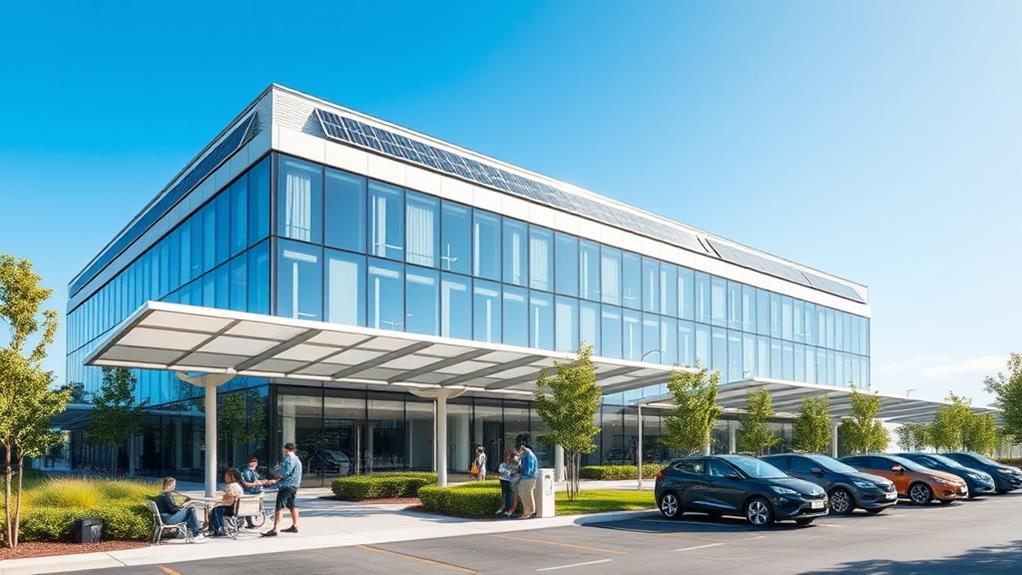
In exploring the commercial and office applications of building-integrated photovoltaics (BIPV), we recognize the dual benefits of significant energy cost reduction and aesthetic design integration. For instance, installations like the Tanjong Pagar Center not only provide substantial energy generation—approximately 125,810 kWh annually—but also enhance the architectural appeal of modern structures. As we examine various case studies, including the energy-neutral Freiburg Town Hall, it's clear that BIPV systems represent a compelling solution for enhancing both sustainability and visual impact in commercial spaces.
Energy Cost Reduction
When it comes to energy savings, commercial buildings have a significant advantage with building-integrated photovoltaics (BIPV). By incorporating solar technologies, we can achieve energy cost reductions of up to 90%, drastically lowering our electricity bills. With self-consumption of on-site energy, we reduce reliance on external power sources, enhancing our operational efficiency. Additionally, BIPV installations yield an impressive ROI of 15-20% within the initial years, making them financially attractive. Meeting green building standards not only opens doors to financial incentives but also aligns our businesses with sustainable practices.
- Enjoy lower electricity bills
- Increase profitability through energy savings
- Achieve compliance with green building standards
- Boost your corporate image
- Contribute to a sustainable future
Aesthetic Design Integration
Building-integrated photovoltaics (BIPV) offer an exciting opportunity to merge sustainability with striking architectural design in commercial and office settings. By integrating photovoltaic panels into architectural elements, we enhance aesthetic appeal while also achieving significant energy generation. For instance, the renovation of King's Cross Station utilized 1,400 glass photovoltaic panels to supply 10% of the station's energy needs. Additionally, Tel Aviv's crystalline silicon glass facade illustrates how innovative designs can create a visual impact while preventing over 1,400 tons of CO₂ emissions. Transparent solar panels in the Grotius Teaching Building allow natural light to flood the space while generating power, showcasing BIPV's versatility. Ultimately, these advancements support our pursuit of carbon neutrality while redefining urban environments through their visual character.
Educational Institution Uses
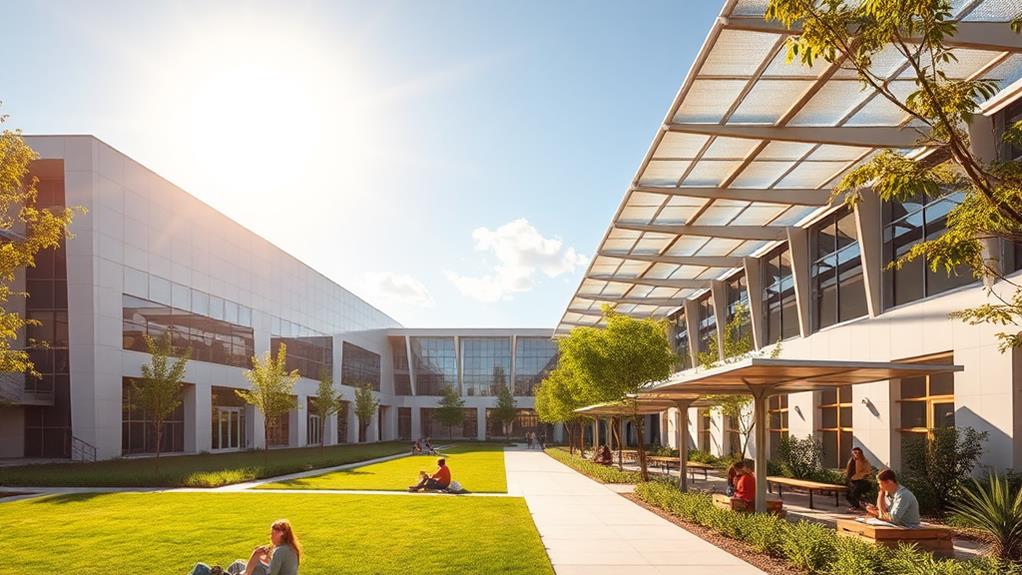
Educational institutions are increasingly adopting building-integrated photovoltaics (BIPV) to enhance sustainability while offering students and the community a firsthand look at renewable energy in action. By integrating photovoltaic panels into rooftops, facades, and windows, these institutions create energy-efficient environments that lower energy costs and reduce carbon footprints. Notable examples include:
- The University of Washington's Life Science Building with vertical photovoltaic fins.
- The Grotius Teaching Building's transparent solar panels enhancing natural light.
- Freiburg Town Hall, generating more energy than it consumes.
- Positive Energy Building: Hikari, producing 15,000 kWh annually.
- LEED-certified campuses serving as living laboratories for renewable energy technology.
Through these BIPV systems, we foster environmental awareness and inspire future generations to embrace sustainable practices.
Healthcare Facility Implementations

Healthcare facilities are turning to building-integrated photovoltaics (BIPV) to guarantee they have a reliable energy supply, especially for critical medical equipment. These innovative solar panels not only enhance patient care during power outages but also considerably lower operational costs. For instance, the University of Washington's Life Science Building showcases a 100kW solar system integrated into its design, while the Grotius Teaching Building features transparent solar panels that provide natural light alongside energy generation. By adopting BIPV, healthcare facilities can reduce their carbon footprints, promoting a sustainable approach to energy consumption. This shift towards renewable energy not only supports operational efficiency but also allows hospitals to allocate more resources towards improving patient care and enhancing facility capabilities.
Public Infrastructure Applications
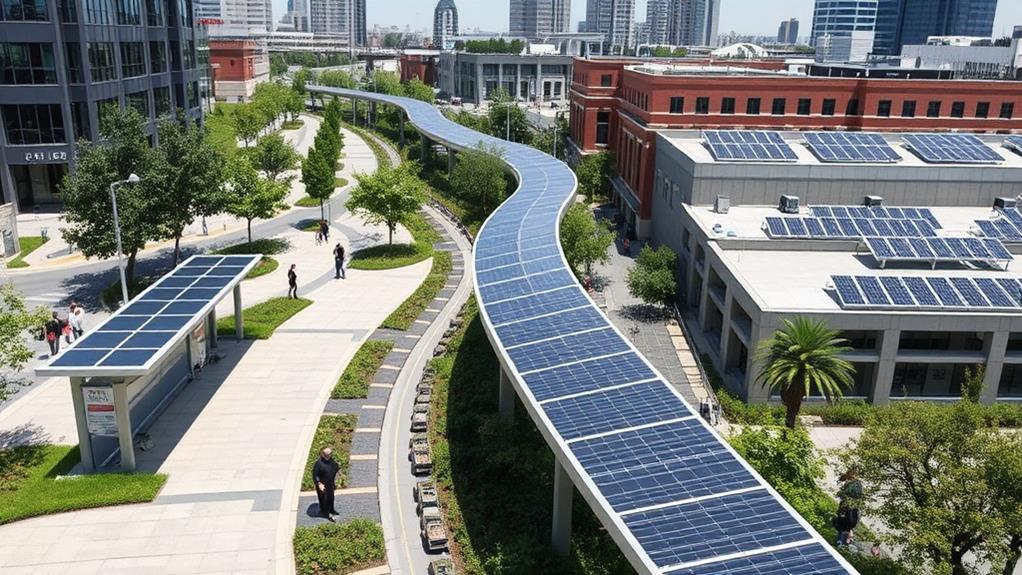
Public infrastructure is increasingly embracing innovative solutions like photovoltaics to enhance energy efficiency and sustainability. As we explore BIPV applications, we see their transformative impact on public buildings and urban landscapes:
- Solar canopies over parking lots provide shade while generating substantial electricity.
- BIPV installations on bus shelters improve energy efficiency and user experience.
- Streetlights powered by solar technology reduce operational costs and installation complexity.
- Educational opportunities arise from integrating renewable energy into municipal facilities.
- Notable projects, like Singapore's Tanjong Pagar Center, showcase significant energy generation.
These advancements not only support municipal operations but also align with our collective vision of a sustainable and resilient future, where urban infrastructure is empowered by renewable energy, fostering freedom from reliance on fossil fuels.
Future Trends in BIPV

As we look ahead, the future of building-integrated photovoltaics (BIPV) appears promising, with the market projected to grow at an impressive compound annual growth rate of 17.0% over the next five years. This growth is stimulated by increasing policy support and a focus on renewable energy solutions in building designs. Innovations in materials, such as transparent and flexible solar panels, are enhancing design flexibility and aesthetic integration, allowing for more diverse applications in modern architecture. Urbanization trends further drive BIPV adoption in high-rise buildings, exemplified by the Hanwha Group headquarters in South Korea. Additionally, advancements in photovoltaic technologies, particularly perovskite materials, promise improved energy conversion efficiency and reduced manufacturing costs, making BIPV solutions increasingly accessible and effective for sustainable building energy management.
Frequently Asked Questions
What Are the Applications of Building-Integrated Photovoltaics?
When we explore building-integrated photovoltaics, we see their role in energy efficiency and architectural design. They enhance urban planning, promote sustainable materials, and offer aesthetic integration, leading to cost reduction, grid independence, and climate resilience for all.
What Are the Applications of Photovoltaic Solar System?
When we harness solar energy, we tap into renewable resources that enhance energy efficiency and promote grid independence. This approach fosters sustainable urban development, reduces environmental impact, and offers significant cost savings through effective energy storage solutions.
What Are Some of the Potential Use Cases and Applications for BIPV Solutions?
We're excited about BIPV's potential! It merges urban energy needs with architectural aesthetics, driving renewable integration and energy independence. With technological advancements, smart buildings can achieve cost savings while reducing environmental impact, empowering our sustainable future.
What Are the Benefits of Building-Integrated Photovoltaics?
We love how building-integrated photovoltaics boost energy efficiency while enhancing aesthetic appeal. They offer significant cost savings, promote sustainable design, increase property value, and reduce emissions, driving architectural innovation and fostering urban integration for a brighter future.


